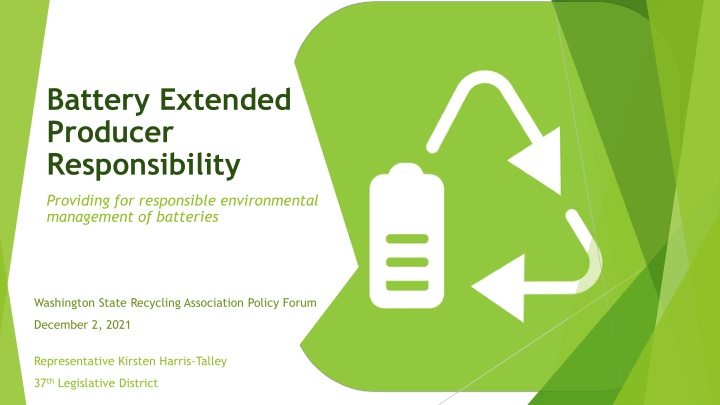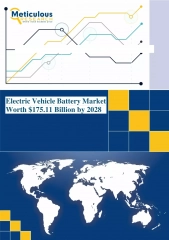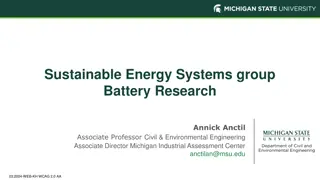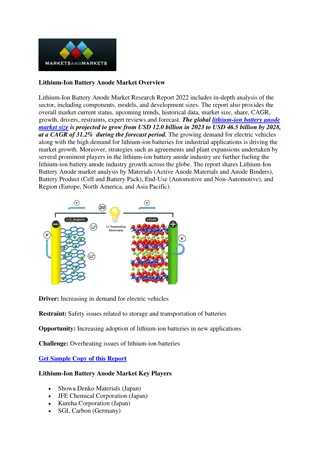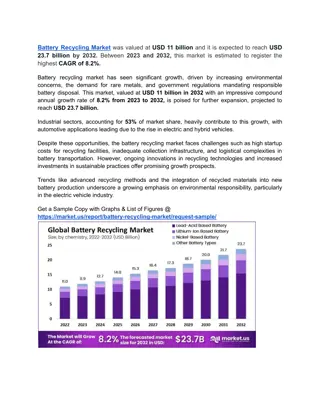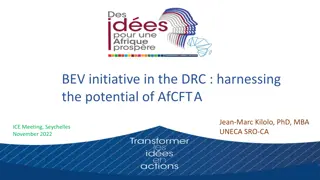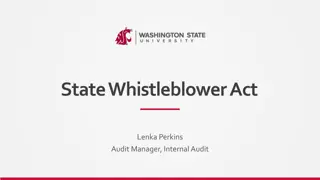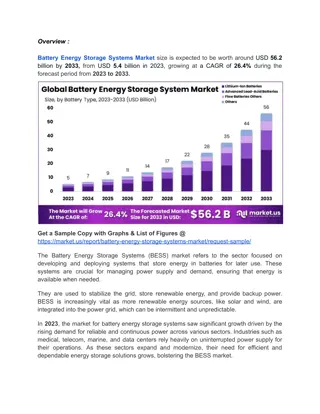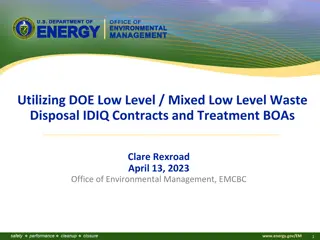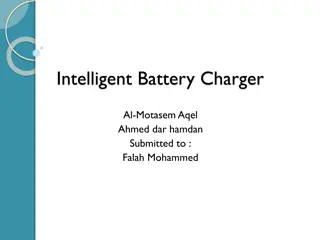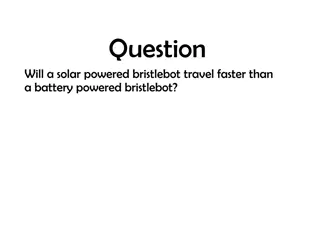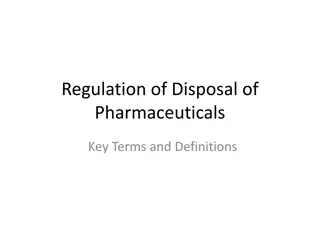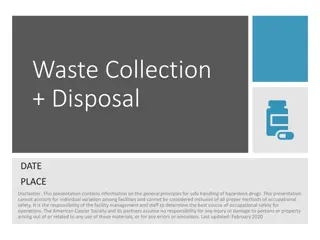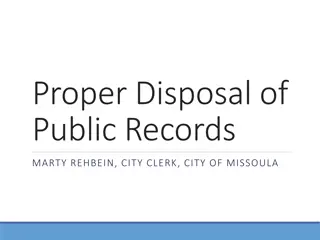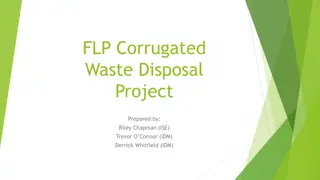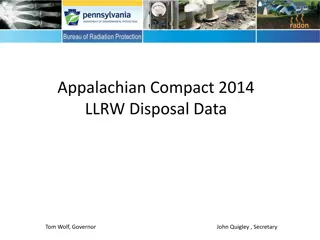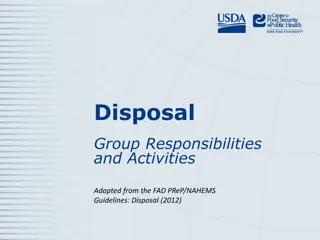Addressing Battery Disposal Challenges in Washington State
Improper battery disposal poses fire risks, financial burdens, and environmental hazards in Washington State. With low recycling rates and labor-intensive waste management, local governments seek solutions to enhance battery recycling and responsible disposal practices.
Download Presentation

Please find below an Image/Link to download the presentation.
The content on the website is provided AS IS for your information and personal use only. It may not be sold, licensed, or shared on other websites without obtaining consent from the author.If you encounter any issues during the download, it is possible that the publisher has removed the file from their server.
You are allowed to download the files provided on this website for personal or commercial use, subject to the condition that they are used lawfully. All files are the property of their respective owners.
The content on the website is provided AS IS for your information and personal use only. It may not be sold, licensed, or shared on other websites without obtaining consent from the author.
E N D
Presentation Transcript
Battery Extended Producer Responsibility Providing for responsible environmental management of batteries Washington State Recycling Association Policy Forum December 2, 2021 Representative Kirsten Harris-Talley 37thLegislative District
WHY NOW, WHY WA Our landfills and waste facilities experience increasing numbers of fires due to the improper disposal of batteries. Taxpayers pay for the expensive and dangerous emergency response and cleanup Washingtonians and WA businesses use a lot of batteries; and continue to embrace new technologies www.dwswa.org/recycle-reuse-articles/2018/11/26/is-your-trash-causing-fires-common-batteries-lead-to-facility-fires
Battery usage grows https://li-cycle.com/2019/09/30/why-recycling-lithium-batteries-matters/
Recycling rate is low Despite voluntary industry programs to collect and recycle batteries, like Call2Recycle, only 12%-15% of rechargeable batteries (and a much smaller percentage of single use batteries) are being recycled in the U.S.
. Leading to an increasing number of fires in material recovery facilities, waste collection trucks, and landfills caused by improperly disposed batteries. These fires endanger the lives of workers, pollute the atmosphere and surrounding areas, and cause expensive damage to city and county waste collection facilities. Bellevue, Washington April 4, 2018 A lithium-ion battery fire in a garbage truck forced the driver to empty garbage onto the street to be extinguished, disrupting service for customers and creating a traffic hazard for community members and first responders.
Expensive for local governments To combat the threat of fires, some jurisdictions in Washington use chemical imaging cameras to monitor the tipping floor for hot spots caused by batteries.
Labor Intensive Batteries are labor intensive for local hazardous waste programs to manage. Collection staff must sort batteries according to chemistries and tape the ends of batteries to prevent fires. This leads to increased labor costs.
Current conditions WA businesses are required to use utilize battery recycling organizations for proper storage and disposal. Residents are encouraged to take batteries to a hazardous waste collection facility instead of throwing them away. Batteries collection from King County residents at a Hazardous Waste Program Collection site in King County.
WASHINGTON CAN DO MORE
Existing Laws Washington D.C. Battery and Critical Mineral Recycling Act Vermont Product Stewardship Program for Primary Batteries Florida Relating to Rechargeable Batteries Iowa Household Batteries Recycling (1996) Maine Regulation of Certain Dry-Cell Batteries Minnesota Rechargeable Batteries and Products Maryland Rechargeable Batteries New Jersey Battery Management Plan 2021 2014 2003 1996 1995 1994 1993 1991 Introduced: New York (2021), California (2021), Washington (2019)
Extended Producer Responsibility Extended Producer Responsibility Programs require manufacturers to be financially responsible for their products at end of life. This provides incentives for manufacturers to make products that last longer or are easier to recycle, and shifts costs off local governments and their ratepayers.
Extended Producer Responsibility Program Producers join a Producer Responsibility Organization (PRO) Convenient access to drop off locations (fewer sites for medium batteries) Submit a plan to Ecology Performance: (a) Rate of battery collection for recycling Program starts (b) The recycling efficiency of the program (at least 70% for rechargeable batteries and at least 80% for primary batteries) Retailers can only sell batteries of manufacturers which are registered in PRO (c) public awareness of the program
Three tiers of batteries Portable battery weighs 11 pounds or less and that has a watt-hour rating of no more than 300 Watt-hours. Medium Format battery (a) weighs at least 11 pounds or has a capacity of at least three hundred watt hours, or both; and (b) weighs less than 25 pounds and has a capacity of less than 1,000 watt hours. Large format battery exceeds 25 pounds in weight or 1000 watt hours.
Commerce Assessment of Large Format Batteries Commerce, in consultation Ecology, must complete an assessment of the opportunities and challenges associated with the end of life management of large format batteries. The assessment must identify adjustments to the stewardship program requirements that are necessary to maximize public health, safety, and environmental benefits, such as battery reuse. https://electrek.co/2021/08/20/us-large-scale-battery-storage-capacity-is-up-35-in-2020-and-growing/
Commerce Assessment of Large Format Batteries Commerce, in consultation Ecology, must complete an assessment of the opportunities and challenges associated with the end of life management of large format batteries. The assessment must identify adjustments to the stewardship program requirements that are necessary to maximize public health, safety, and environmental benefits, such as battery reuse. Ecology may adopt rules that require producers of large format batteries to participate in a stewardship program that substantially fulfills the types of requirements established for medium format batteries https://electrek.co/2021/08/20/us-large-scale-battery-storage-capacity-is-up-35-in-2020-and-growing/
http://www.sviva.gov.il/English/env_topics/Solid_Waste/Extended-Producer-http://www.sviva.gov.il/English/env_topics/Solid_Waste/Extended-Producer- Responsibility/Pages/default.aspx Thank you Representative Kirsten Harris-Talley, 37th LD Kirsten.Harris-Talley@leg.wa.gov
